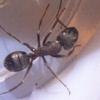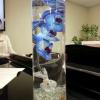Adult queens and workers are perfectly capable of removing the seed coat of Nyger and Poppy seeds on their own. Crushing them and then giving the opened contents to the ants is not really necessary. That's the beauty of the seed coat. It protects the seed contents until the ants need them.
As an aside, I have seen males and queens of P. tenuispina. rugosus and montanus consume small particles of crushed raisin bran flakes. I suspect the generalization that no adult ants can consume solid food may not be universally true for every species. I was surpised to see the Pogonomyrmex tenuispina males do this as most written material seems to indicate that males must be fed by their sisters.
I currently have an adult colony of P. tenuispina raised from a few fertile queens on supermarket-sourced Poppy seeds, Black Nyger seeds and crushed-up dried 'All Living Things' brand of Freeze Dried Medley for Bearded Dragons. (Pet Smart) Except for crushing-up the whole freeze-dried insects, the ants themselves have processed all the food themselves. I don't see a need to crush-up seeds for them. All Pogonomyrmex colonies store the seeds whole until right before they are feed to the brood. The exposed contents start to spoil from oxidation and microbial activity. These seeds sustain the queen through the initial brood production until her new workers start feeding her. I am certain my high success rate raising delate Pogonomyrmex queens is partially due to supplying them with seeds, even if they are suspected or known for being fully-claustral.



















